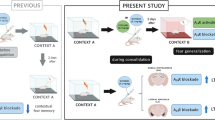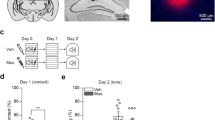Abstract
Deep brain stimulation (DBS) of the amygdala has been demonstrated to modulate hyperactivity of the amygdala, which is responsible for the symptoms of post-traumatic stress disorder (PTSD), and thus might be used for the treatment of PTSD. However, the underlying mechanism of DBS of the amygdala in the modulation of the amygdala is unclear. The present study investigated the effects of DBS of the amygdala on synaptic transmission and synaptic plasticity at cortical inputs to the amygdala, which is critical for the formation and storage of auditory fear memories, and fear memories. The results demonstrated that auditory fear conditioning increased single-pulse-evoked field excitatory postsynaptic potentials in the cortical–amygdala pathway. Furthermore, auditory fear conditioning decreased the induction of paired-pulse facilitation and long-term potentiation, two neurophysiological models for studying short-term and long-term synaptic plasticity, respectively, in the cortical–amygdala pathway. In addition, all these auditory fear conditioning-induced changes could be reversed by DBS of the amygdala. DBS of the amygdala also rescued auditory fear conditioning-induced enhancement of long-term retention of fear memory. These findings suggested that DBS of the amygdala alleviating fear conditioning-induced alterations in synaptic plasticity in the cortical–amygdala pathway and fear memory may underlie the neuromodulatory role of DBS of the amygdala in activities of the amygdala.




Similar content being viewed by others
References
Akirav I, Maroun M (2007) The role of the medial prefrontal cortex-amygdala circuit in stress effects on the extinction of fear. Neural Plast 2007:30873
Armony JL, Servan-Schreiber D, Romanski LM, Cohen JD, LeDoux JE (1997) Stimulus generalization of fear responses: effects of auditory cortex lesions in a computational model and in rats. Cereb Cortex 7(2):157–165
Baker KB, Kim JJ (2004) Amygdalar lateralization in fear conditioning: evidence for greater involvement of the right amygdala. Behav Neurosci 118(1):15–23
Bisson JI (2008) Pharmacological treatment to prevent and treat post-traumatic stress disorder. Torture 18(2):104–106
Bliss TV, Collingridge GL (1993) A synaptic model of memory: long-term potentiation in the hippocampus. Nature 361(6407):31–39
Blomstedt P, Sjöberg RL, Hansson M, Bodlund O, Hariz MI (2011) Deep brain stimulation in the treatment of depression. Acta Psychiatr Scand 123(1):4–11
Boatman JA, Kim JJ (2006) A thalamo-cortico-amygdala pathway mediates auditory fear conditioning in the intact brain. Eur J Neurosci 24(3):894–900
Breit S, Schulz JB, Benabid AL (2004) Deep brain stimulation. Cell Tissue Res 318(1):275–288
Burdick AP, Foote KD (2011) Advancing deep brain stimulation for obsessive-compulsive disorder. Expert Rev Neurother 11(3):341–344
Campeau S, Davis M (1995) Involvement of subcortical and cortical afferents to the lateral nucleus of the amygdala in fear conditioning measured with fear-potentiated startle in rats trained concurrently with auditory and visual conditioned stimuli. J Neurosci 15(3 Pt 2):2312–2327
Coffey RJ (2001) Deep brain stimulation for chronic pain: results of two multicenter trials and a structured review. Pain Med 2(3):183–192
Das P, Kemp AH, Liddell BJ, Brown KJ, Olivieri G, Peduto A, Gordon E, Williams LM (2005) Pathways for fear perception: modulation of amygdala activity by thalamo-cortical systems. Neuroimage 26(1):141–148
Doyère V, Schafe GE, Sigurdsson T, LeDoux JE (2003) Long-term potentiation in freely moving rats reveals asymmetries in thalamic and cortical inputs to the lateral amygdala. Eur J Neurosci 17(12):2703–2715
Duncan GH, Bushnell MC, Marchand S (1991) Deep brain stimulation: a review of basic research and clinical studies. Pain 45(1):49–59
Grover PJ, Pereira EA, Green AL, Brittain JS, Owen SL, Schweder P, Kringelbach ML, Davies PT, Aziz TZ (2009) Deep brain stimulation for cluster headache. J Clin Neurosci 16(7):861–866
Halpern CH, Wolf JA, Bale TL, Stunkard AJ, Danish SF, Grossman M, Jaggi JL, Grady MS, Baltuch GH (2008) Deep brain stimulation in the treatment of obesity. J Neurosurg 109(4):625–634
Hamani C, Dubiela FP, Soares JC, Shin D, Bittencourt S, Covolan L, Carlen PL, Laxton AW, Hodaie M, Stone SS, Ha Y, Hutchison WD, Lozano AM, Mello LE, Oliveira MG (2010) Anterior thalamus deep brain stimulation at high current impairs memory in rats. Exp Neurol 225(1):154–162
Hariz MI, Robertson MM (2010) Gilles de la Tourette syndrome and deep brain stimulation. Eur J Neurosci 32(7):1128–1134
Humeau Y, Herry C, Kemp N, Shaban H, Fourcaudot E, Bissière S, Lüthi A (2005) Dendritic spine heterogeneity determines afferent-specific Hebbian plasticity in the amygdala. Neuron 45(1):119–131
Kahane P, Depaulis A (2010) Deep brain stimulation in epilepsy: what is next? Curr Opin Neurol 23(2):177–182
Koenigs M, Grafman J (2009) Posttraumatic stress disorder: the role of medial prefrontal cortex and amygdala. Neuroscientist 15(5):540–548
Koenigs M, Huey ED, Raymont V, Cheon B, Solomon J, Wassermann EM, Grafman J (2008) Focal brain damage protects against post-traumatic stress disorder in combat veterans. Nat Neurosci 11(2):232–237
Langevin JP, De Salles AA, Kosoyan HP, Krahl SE (2010) Deep brain stimulation of the amygdala alleviates post-traumatic stress disorder symptoms in a rat model. J Psychiatr Res 44(16):1241–1245
LeDoux JE (2000) Emotion circuits in the brain. Annu Rev Neurosci 23:155–184
Li JS, Hsiao KY, Chen WM (2011) Effects of medial prefrontal cortex lesions in rats on the what-where-when memory of a fear conditioning event. Behav Brain Res 218(1):94–98
Limousin P, Martinez-Torres I (2008) Deep brain stimulation for Parkinson’s disease. Neurotherapeutics 5(2):309–319
Maren S (2001) Neurobiology of Pavlovian fear conditioning. Annu Rev Neurosci 24:897–931
Maren S (2003) The amygdala, synaptic plasticity, and fear memory. Ann NY Acad Sci 985:106–113
Maren S (2005) Synaptic mechanisms of associative memory in the amygdala. Neuron 47(6):783–786
McKernan MG, Shinnick-Gallagher P (1997) Fear conditioning induces a lasting potentiation of synaptic currents in vitro. Nature 390(6660):607–611
Nieuwenhuis IL, Takashima A (2011) The role of the ventromedial prefrontal cortex in memory consolidation. Behav Brain Res 218(2):325–334
Paxinos G, Watson C (1997) The rat brain in stereotaxic coordinates. Academic Press Inc, San Diego
Phelps EA, LeDoux JE (2005) Contributions of the amygdala to emotion processing: from animal models to human behavior. Neuron 48(2):175–187
Pissiota A, Frans O, Fernandez M, von Knorring L, Fischer H, Fredrikson M (2002) Neurofunctional correlates of posttraumatic stress disorder: a PET symptom provocation study. Eur Arch Psychiatry Clin Neurosci 252(2):68–75
Quirk GJ, Armony JL, LeDoux JE (1997) Fear conditioning enhances different temporal components of tone-evoked spike trains in auditory cortex and lateral amygdala. Neuron 19(3):613–624
Rodrigues SM, Schafe GE, LeDoux JE (2004) Molecular mechanisms underlying emotional learning and memory in the lateral amygdala. Neuron 44(1):75–91
Rogan MT, Stäubli UV, LeDoux JE (1997) Fear conditioning induces associative long-term potentiation in the amygdala. Nature 390(6660):604–607
Romanski LM, LeDoux JE (1993) Information cascade from primary auditory cortex to the amygdala: corticocortical and corticoamygdaloid projections of temporal cortex in the rat. Cereb Cortex 3(6):515–532
Romanski LM, Clugnet MC, Bordi F, LeDoux JE (1993) Somatosensory and auditory convergence in the lateral nucleus of the amygdala. Behav Neurosci 107(3):444–450
Schafe GE, Nader K, Blair HT, LeDoux JE (2001) Memory consolidation of Pavlovian fear conditioning: a cellular and molecular perspective. Trends Neurosci 24(9):540–546
Schroeder BW, Shinnick-Gallagher P (2005) Fear learning induces persistent facilitation of amygdala synaptic transmission. Eur J Neurosci 22(7):1775–1783
Shin LM, Orr SP, Carson MA, Rauch SL, Macklin ML, Lasko NB, Peters PM, Metzger LJ, Dougherty DD, Cannistraro PA, Alpert NM, Fischman AJ, Pitman RK (2004) Regional cerebral blood flow in the amygdala and medial prefrontal cortex during traumatic imagery in male and female Vietnam veterans with PTSD. Arch Gen Psychiatry 61(2):168–176
Shin RM, Tsvetkov E, Bolshakov VY (2006) Spatiotemporal asymmetry of associative synaptic plasticity in fear conditioning pathways. Neuron 52(5):883–896
Sierra-Mercado DJ, Corcoran KA, Lebrón-Milad K, Quirk GJ (2006) Inactivation of the ventromedial prefrontal cortex reduces expression of conditioned fear and impairs subsequent recall of extinction. Eur J Neurosci 24(6):1751–1758
Siguròsson T, Doyère V, Cain CK, LeDoux JE (2007) Long-term potentiation in the amygdala: a cellular mechanism of fear learning and memory. Neuropharmacology 52(1):215–227
Siguròsson T, Cain CK, Doyère V, LeDoux JE (2010) Asymmetries in long-term and short-term plasticity at thalamic and cortical inputs to the amygdala in vivo. Eur J Neurosci 31(2):250–262
Skuse DH, Morris JS, Dolan RJ (2005) Functional dissociation of amygdala-modulated arousal and cognitive appraisal, in Turner syndrome. Brain 128(Pt 9):2084–2096
Starr PA, Vitek JL, Bakay RA (1998) Ablative surgery and deep brain stimulation for Parkinson’s disease. Neurosurgery 43(5):989–1013
Stehberg J, Levy D, Zangen A (2009) Impairment of aversive memory reconsolidation by localized intracranial electrical stimulation. Eur J Neurosci 29(5):964–969
Sui L, Wang J, Li BM (2008) Role of the phosphoinositide 3-kinase-Akt-mammalian target of the rapamycin signaling pathway in long-term potentiation and trace fear conditioning memory in rat medial prefrontal cortex. Learn Mem 15(10):762–776
Tronson NC, Schrick C, Guzman YF, Huh KH, Srivastava DP, Penzes P, Guedea AL, Gao C, Radulovic J (2009) Segregated populations of hippocampal principal CA1 neurons mediating conditioning and extinction of contextual fear. J Neurosci 29(11):3387–3394
Tsvetkov E, Carlezon WA, Benes FM, Kandel ER, Bolshakov VY (2002) Fear conditioning occludes LTP-induced presynaptic enhancement of synaptic transmission in the cortical pathway to the lateral amygdala. Neuron 34(2):289–300
Vetere G, Restivo L, Cole CJ, Ross PJ, Ammassari-Teule M, Josselyn SA, Frankland PW (2011) Spine growth in the anterior cingulate cortex is necessary for the consolidation of contextual fear memory. Proc Natl Acad Sci USA 108(20):8456–8460
Acknowledgments
This work was supported by the National Natural Science Foundation of China (11179015, 51173108) and Innovation Program of Shanghai Municipal Education Commission (12ZZ143) to L. Sui.
Author information
Authors and Affiliations
Corresponding author
Rights and permissions
About this article
Cite this article
Sui, L., Huang, S., Peng, B. et al. Deep brain stimulation of the amygdala alleviates fear conditioning-induced alterations in synaptic plasticity in the cortical–amygdala pathway and fear memory. J Neural Transm 121, 773–782 (2014). https://doi.org/10.1007/s00702-014-1183-5
Received:
Accepted:
Published:
Issue Date:
DOI: https://doi.org/10.1007/s00702-014-1183-5




